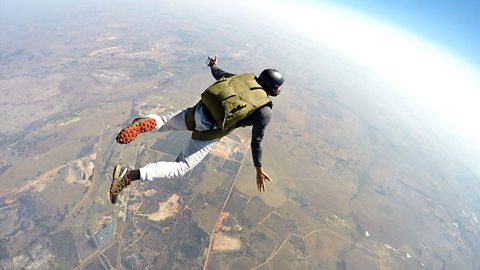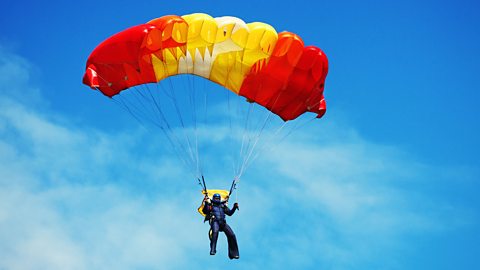Key Points
When an object is falling, the two main forces acting on it are weightA force that acts on mass, pulling it down, due to gravity. Weight is a force and forces are measured in newtons (N). and air resistanceA force that acts on an object which is moving through air. Air resistance acts in the opposite direction to the direction of movement, so it acts to slow down the moving object..
When an object falls it can reach terminal velocityThe maximum velocity achieved by an object freely falling through a gas or liquid..
This is the maximum velocity it can reach when all the forces are balanced.
Review of forces

A Force A force is a push or a pull that acts on an object. is a push or a pull that acts on an object.
There are two types of forces:
- a contact force - objects touch each other and exert a force
or
- non-contact force - objects do not have to touch each other to exert a force.
Force is measured in newtons (N).
When two or more forces act on an object a resultant forceThe overall force acting on the object. can be calculated.
The size and direction of the resultant force enables us to describe how the motion of the object changes. For example, it might speed up, slow down or change direction.
Click here to revise balanced and unbalanced forces.
If an object is moving upwards and the forces acting on the object are unbalanced, there is a resultant force. The resultant force is acting in the same direction as the motion.
In this diagram, the object is accelerating, or speeding up.
If an object is moving downwards and the forces acting on the object are unbalanced, there is a resultant force. The resultant force is acting in the opposite direction to the motion.
In this diagram, the object is decelerating, or slowing down.
Free fall
When an object is falling, the two main forces acting on it are weightA force that acts on mass, pulling it down, due to gravity. Weight is a force and forces are measured in newtons (N). and air resistanceA force that acts on an object which is moving through air. Air resistance acts in the opposite direction to the direction of movement, so it acts to slow down the moving object..
The weight of the object remains constant throughout the fall. The weight of the object is the force due to the mass being acted on by Earth's gravity.
The air resistance is a frictional force which acts against the movement of the object. However, if an object is falling in a vacuum there is no air resistance.
As an object falls it accelerates to begin with. The faster the object is travelling the greater the air resistance acting against it.
Terminal Velocity
Terminal velocity is the maximum speed achieved by an object freely falling through a gas or liquid.
At terminal velocity, the forces acting on the object are balanced so it is no longer accelerating.
For example, when a skydiver jumps from an aeroplane, they speed up because to begin with the resultant forceThe overall force acting on the object. is less than their weight. As they speed up, the air resistance increases until the two forces are balanced, so they eventually reach a maximum speed and don’t go any faster. This is their terminal velocity.
The two main factors which affect the terminal velocity of an object falling through a fluid are the mass and the shape of the object. The larger the mass of the object, the greater the weight.
Objects with large surface areas will often experience a large amount of air resistance when they move. We describe these objects as being less aerodynamicsThis describes how air moves around an object. An aerodynamic object is often described as streamlined..
Higher terminal velocity

Smaller surface area = less air resistance.
For example, when a person falls, their surface area is relatively small which produces only a small amount of air resistance. The person is able to reach a high terminal velocity.

Lower terminal velocity

Large surface area = more air resistance.
For example, when a parachutist opens their parachute, the surface area increases. This produces a large amount of air resistance. The parachutist is able to reach a low terminal velocity.

Describing the motion of a falling object
These diagrams show what happens as a parachutist jumps out of a plane, freefalls, and then opens her parachute.
- The skydiver jumps out of the plane and accelerates.
- The skydiver continues to accelerate. As she speeds up the air resistance increases.
- The skydiver has reached terminal velocity - weight and air resistance are balanced.
- The skydiver pulls her parachute. This drastically increases her surface area which increases the air resistance and slows her down.
- The skydiver is decelerating. As she slows down the air resistance decreases.
- The skydiver has reached a new lower terminal velocity. The terminal velocity here is much slower than the terminal velocity of the skydiver before she opened her parachute.
Test your knowledge
Quiz - Multiple choice
Play the Atomic Labs game! gamePlay the Atomic Labs game!
Try out practical experiments in this KS3 science game.

More on Forces and movement
Find out more by working through a topic
- count9 of 16

- count10 of 16

- count11 of 16

- count12 of 16
